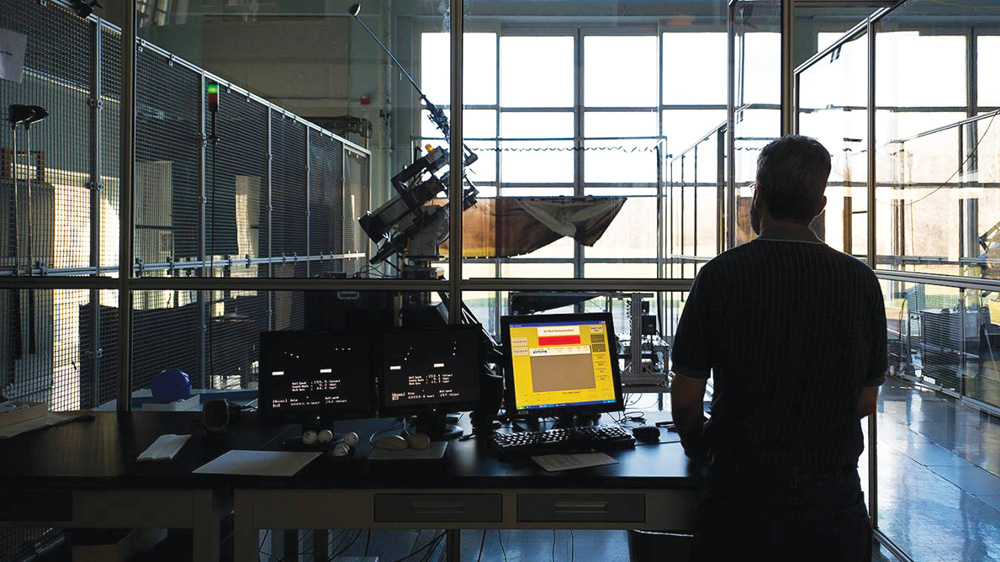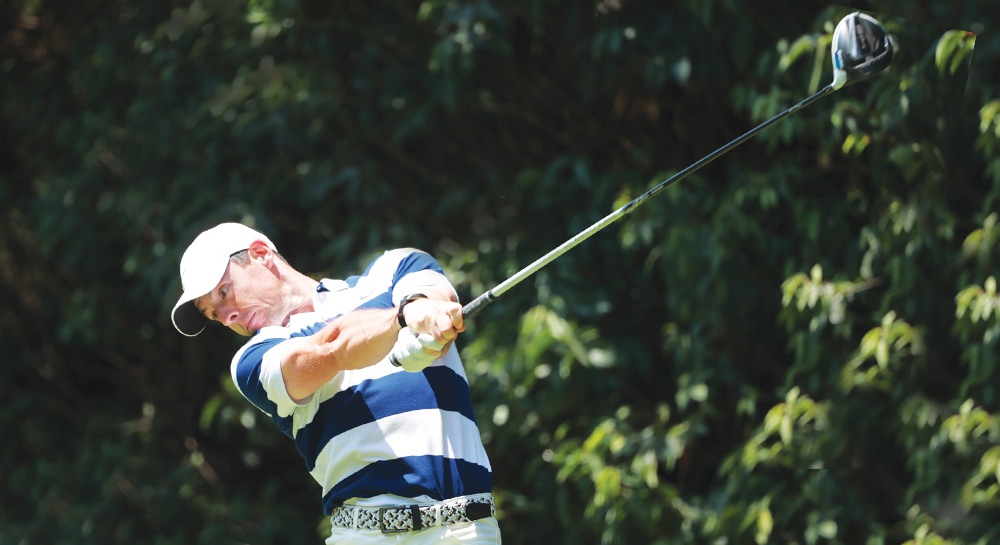As if the game of golf did not have enough on its collective plate at present, global governing bodies find themselves wrestling with an issue they have ignored for too many years, namely distance control in general and length off the tee in particular. Now, after the sporting equivalent of rearranging the deck chairs on the Titanic for generations, the R&A and the USGA have finally spoken, recently publishing their joint ‘Distance Insights Report’ which, thorough and worthy though it may be, asks as many questions as it provides answers. Mike Wilson asks the big question … does length matter?
Over its long, rich and colourful history spanning 500 years and more, the game of golf has invariably grappled with the thorny issue of innovation in general … in particular, how the latest modifications, variations and modernisations, many small, some more fundamental, can best be harnessed and dovetailed within the overall structure of the game, its ethical codes and it regulatory norms.
Way back when, the humble golf ball, made originally from solid and unforgiving hardwood, underwent a massive change in the 17th century with the advent of the ‘featherie’, a significant design improvement involving a leather-coated ball stuffed with bird feathers and stitched closed.
But, 250 years later, even the faithful featherie’s time was up, overtaken and replaced by the ground-breaking gutta percha ball, made from the dried sap of the Malaysian sapodilla tree, cheaper, easier to control and more durable. But the ‘Gutty’ too was, in turn, superseded at the start of the 20th century by the rubber-wound ball, offering significantly greater distance – 20 to 25 yards further off the tee – at a time golf was becoming more popular and accessible.

Golf as it was played during the time of ‘Old’ Tom Morris (L), circa 1854 at St Andrews (©Hulton Archive/Getty Images)
However, the passing of time saw the rubber-wound ball replaced in the late 1950s/early 1960s – just as the ‘Big 3′, Palmer, Nicklaus and Player, were emerging – by the solid-moulded ball, high-tech aerodynamic variations of them still widely in use today. Golf’s dual governing bodies, the R&A and USGA, as recently as 1990, unified around a mutually-agreed golf ball size – 1.68-inches (42.67mm) in diameter – as standard on both sides of the Atlantic and beyond.
And other golf equipment, clubs in particular, went through similar historical periods of evolution and, on occasions, revolution. Starting out with hickory shafts fitted with hardwood or cast iron heads – hence the definitions ‘woods’ and ‘irons,’ sadly long-since-gone terms such as ‘brassie’ (2-wood), ‘mashie’ (5-iron), ‘niblick’ (9-iron) and ‘cleek’, replaced first by steel, then carbon-fibre shafts, one of the greatest changes being the oxymoron that is ‘metalwoods’, defined by Callaway’s introduction of the Big Bertha back in 1991.
The foregoing is not designed as an antiquities lesson in the specialist subject of golf equipment, but to illustrate just how golf’s governing bodies have – with varying degrees of success and failure – had to deal with the innovation, development and roll-out of new ‘technology’, in the broadest sense of the word.

Epic changes in equipment technology have taken place over the last two and a half decades
By the turn of the new millennium and, with ever-increasing momentum since, the game of golf has been careering headlong towards a ‘perfect storm’ comprising ever-more sophisticated technological development of golf equipment, allied with a dramatic improvement in the fitness and physiology of the modern-day professional golfer.
The end result has been the dwarfing of many of the world’s golf courses in general and, specifically, those traditional courses used for elite men’s professional golf … links courses like Open Championship venues such as the Old Course, St Andrews or Augusta National, home of the iconic Masters.
Almost every Major tournament venue has been either enfeebled or emasculated; designed and built in an era where, in the case of the Old Course, hickory shafts were the order of the day, while Augusta National opened when the hardwood ‘persimmon’ was still the material of choice for clubs such as drivers and three-woods.
Both iconic courses and almost every men’s professional tournament venue has been stretched to their very limits, often new land being purchased to extend par-fours that had become little more than pitch-and-putt holes, previously prodigious par-fives now easily reachable in two strokes.
Hitherto legendary and intrepid golf holes and courses had become dwarfed and overwhelmed by muscular athletes/golfers wielding scientifically-designed state-of-the-art equipment, defenceless despite the deployment of sand traps, deep rough and water hazards, making nonsense of perfectly respectable 6,250 to 6,500-yard par-72 courses.

©Robert Cianflone/Getty Images
Despite the best efforts of tournament directors, working hand in glove with club owners and course superintendents in stretching their courses to their very limits and beyond, all too often ‘tricking-up’ hitherto authentic golf courses in order to increase the degree of difficulty and introduce some jeopardy, winning scores in excess of 20-under have become par-for-the-course, crystalising the vast gulf between the golf the pros play and that us amateurs endeavour – to varying degrees of success and failure – to replicate.
On the plus side, those mega-headed, idiot-proof drivers had turned us high-handicappers into players of more modest ability, aiding and assisting the popularity of the game. Custom-fitting of clubs and even golf balls, a service previously only available to the pros, now is an everyday offer to us all. The end result, if not reenergising and repopulating the rapidly falling numbers taking up golf, is at least slowing the decline.
So, what’s to be done about it if golf in general and especially the elite end of the game is to regain its purity, integrity and authenticity?
But two big, burning questions are as much a matter of sporting philosophy as golfing practicality; firstly, once the technological genie is out of the bottle, as in golf it most certainly is and has been for years, is it even possible, let alone right and proper, for golf’s governing bodies to force it back in, effectively stifling the very progress that has underpinned the game for centuries?
Secondly, given that it is golf’s big hitters, the longest drivers – there are currently 16 PGA Tour players who have registered tee-shots of over 400 yards so far this season – are far fitter and much more superiorly skilled than the rest of us, is there a case for what in typical R&A technobabble is called ‘bifurcation’ which, in plain English, means ‘to divide into two separate parts’.
In answer to the first of these two quandaries, it would appear to be – to this correspondent at least – a retrograde step to suppress technological progress. It could perhaps even amount to restraint of trade and therefore open to litigation by the big, well-funded equipment manufacturers who pour billions into R&D.
But it is also considered unsustainable to continue to extend the boundaries of golf courses around the world, where land use is already an issue and where, as is the case with the Old Course in St Andrews (a diminutive 6,721 yards, stretched to 7,305 for The Open) and Augusta National (a pint-sized 6,365 yards expanded to 7,474 for the Masters) – bolt-on land is simply not available.
And, in response to the second conundrum, that pesky issue of bifurcation, specifically providing different equipment to professional players to that supplied to us less-able ordinary mortals, it could be argued that it already happens; high-tech shafts of varying flex, custom-built woods and irons to suit a tour pro’s individual stature and swing, personalised, bespoke golf balls to optimise performance based on the touch, feel and flight of a tour player.
Indeed, it is in this area, the golf ball, that the answer to golf’s chronic distance problem most probably, simply and effectively lies.
Surely it is not beyond the wit of man for those boffins on opposite sides of the spectrum – rule makers and ball manufacturers – to reach a compromise, phased in over several seasons, which, for the tiny percentage of golf’s 70 million-plus players, could rein in prodigious driving distances, making a 300-yard drive the exception rather than the rule.
Otherwise, courses like the International Golf Club’s Pines Course in Massachusetts, USA, currently the fourth-longest golf course in the world measuring 8,325 yards, will, over time, become the new norm.

Conformance testing at the USGA Research & Test Center in Liberty Corner, New Jersey
And, simultaneously, deploying the law of unintended consequences, stretching golf courses closer to and even in excess of 8,000 yards, simply exacerbates an already critical pace-of-play problem; conversely, by taking the distance-restricting golf ball option, the scourge of slow play can be dealt with as the single – and unacceptable – issue it already is.
Having taken several years to compile, after studying ‘100 years’ worth of data’ and ‘informed by a library of 56 supporting documents’, the joint USGA/R&A ‘Distance Insights Report’, all 102 pages of it, makes clear their aversion to and distaste for the causes and effects of the increasingly prodigious distances the top few hundred – a miniscule proportion of the world golfing community – players are blasting the golf ball and bombarding golf courses around the world.
But what in essence is a thorough, theoretical, evidence-based report is also depressingly short on concrete recommendations, let alone providing answers to a problem that will not only not go away unless radical action is taken and soon.
With relentless technological advancement and the appliance of science in a free-market economy exacerbating and adding to golf’s mounting list of challenges, the game must face – and address – them to remain relevant in the decades and centuries ahead and go the distance in a world where alternative options increasingly abound.














